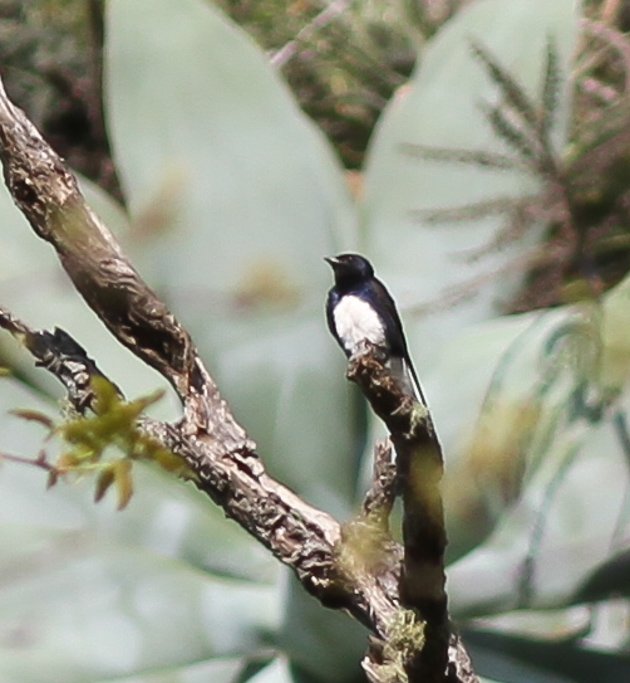
Kathi Borgmann and Josh Beck are living the dream of many a North American birder. They packed up in June of 2013 and headed south from San Diego with the southern tip of South America as their destination. Like so many trips this one is more about the journey than the destination which brings us to why they have a guest post (hopefully the first of several) on 10,000 Birds. En route they will be “birding in nearly every country in mainland North and South America,” and, as they say on their excellent blog, “Our journey is about collecting valuable data on bird species, their status and distribution, current conservation issues, and more along the way. We hope that our journey will provide important information about many Neotropical bird species as well as inform conservation.”
When we think of going birding in Mexico we often think about the colorful tropical species; Russet-crowned Motmot, Eared Quetzal, Black-throated Magpie-Jay…However, searching for rare and little understood species can perhaps be even more exciting and rewarding. Spending days searching for an elusive bird you finally get to see, a bird that few others have seen, a bird about which very little is even known, and then seeing it is a tremendous and unforgettable experience. If there is one bird in Mexico that remains a mystery and is difficult to see it is the Sinaloa Martin. Very little is known about this enigmatic species. The non-breeding distribution is virtually unknown, although they are suspected to winter in northern South America (Howell and Web 1995). Clutch size, incubation period, time to fledge, and eggs are all undescribed. Until recently the vocalizations of Sinaloa Martin were unknown and known breeding sites are few and far between. Despite extensive research Lethaby and King (2010) found few records and conclude that this species is rare indeed. Sinaloa Martins are rarely detected across their range and recently reports suggest that populations of Sinaloa Martins have declined (Lethaby and King 2010). Causes for decline are unknown, but logging may have reduced the availability of nesting trees which may have contributed to their decline.
Sinaloa Martin Progne sinaloae
The Sinaloa Martin breeds on the western slope of the Sierra Madre Occidental (elevation range 1100-2800 m) in western Mexico from Sonora south to Jalisco and Michoacán in pine-oak forests (Howell and Webb 1995). They breed in small colonies often in snags, but more recently reports suggest that the Sinaloa Martin may also be breeding in crevices on cliffs. We witnessed four male Martins flying, feeding and vocalizing in front of a limestone cliff, with occasional entrances into crevices in the cliff. This behavior leads us to agree that this is a very likely breeding site and that the Martins, at least along the Mázatlan-Durango Highway, are using a cliff face to breed.
Adding to the mystery of the Sinaloa Martin is the fact that its plumage is extremely similar to the Caribbean Martin, making identification of wintering martins in South America essentially impossible. In fact, these two birds were previously considered conspecific, despite breeding thousands of kilometers apart in wildly disparate habitats. Summer identification is trivial based upon range alone, however for wintering birds it is still merely a presumption that martins seen in northern South America in the winter are Caribbean Martins and that some of them may also be Sinaloa Martins.
Before beginning our trip, Sinaloa Martin was on our target list so we were always on the lookout. Stopping along the Petaca Road on our way up the Durango-Mázatlan Highway, we very briefly saw a suspiciously large swallow that was nearly certainly a martin but not seen well at all and went unidentified. We next stopped at the KM 211 marker, where others have reported seeing Sinaloa Martins near a cliff face. It was late in the afternoon with gray skies and intermittent rain. We scanned the skies, the snags in the area and the cliff face for Martins, but to no avail. We decided to try again early in the morning two days later at the same pullout. As we parked and started birding the skies were quiet, but after 10 minutes, we heard what sounded like martins calling above. We put our binoculars up and BAM there they were, four male Sinaloa Martins foraging around a cliff and resting on a tall snag below the cliff face. We were ecstatic! Neither one of us thought we would be able to see this bird, amazing! After briefly marveling at this rare creature, we decided that it might be possible to record the martins’ chatter for the Macaulay Library at the Cornell Lab of Ornithology. Recording this particular group of birds was challenging as semis roared down the highway and a steep cliff face prevented us from getting closer to the birds. Despite these challenges we managed to get one of the few recordings that exist for the Sinaloa Martin. Therein lies the reward for searching for the more elusive and less-colorful birds!
For more information on birding the Durango-Mázatlan Highway and birding throughout the Americas please visit our blog.
For more information on the Sinaloa Martin you can visit these sites:
http://neotropical.birds.cornell.edu/portal/species/overview?p_p_spp=521996
http://www.neotropicalbirdclub.org/articles/32/Lethaby.pdf














Congrats on finding that little known species and sharing your account! Hope to see you guys in Costa Rica.
Well done! Very tough, very mysterious bird.
After two days and 8 hours staring up the rock face at km211 on the mazatlan-durango hwy i finally saw 2 martins flying and calling overhead on august 4 eventually landing and spending lotsof time just siting on the snags below the rock face.